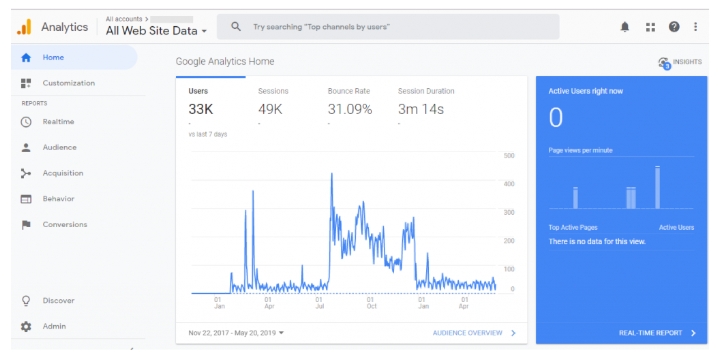Ecommerce Analytics is the new big thing to be familiar with now, especially if you run an online business. Planning is necessary for effective strategies.
Innovative businesses build on past successes and test new ideas to ensure a better future.
WHY YOU SHOULD KNOW ABOUT E-COMMERCE ANALYTICS
There are so many fantastic reasons why you should know about eCommerce.
Firstly, Ecommerce analytics is the practice of gathering information from every source that affects your store.
Then, use this information to understand changes in consumer behavior and to emerge online buying patterns.
Ultimately, basing judgments on data allows you to make better-informed choices, which should increase online sales.
Ecommerce analytics can encompass a wide range of indicators about the entire customer journey, such as discovery, acquisition, conversion, retention, and advocacy.
Your ability to make data-driven decisions is facilitated by the obtained data, which gives you a greater insight into customer behavior.
Lead generation and sales may rise as a result of this. Audience, acquisition, behavior, conversions, and paid marketing efforts are a few examples of the many e-commerce analytics.
Recently, there has been a significant expansion in the e-commerce industry.
E-commerce businesses are sprouting up like mushrooms due to the pandemic’s effects and consumers’ changing shopping preferences.
Naturally, a more crowded market necessitates improvements in the management of e-commerce companies.
Even essential marketing and digital promotion are no longer sufficient, as having a store has never been enough.
And for sure, you need to rely more on data than ever before if you want to grow your e-commerce firm.
The Benefits Of E-Commerce Analytics

Any e-commerce business nowadays must prioritize gathering client data. Managers and business owners can use it to make data-driven decisions.
Online businesses are unable to compete effectively in the market without e-commerce analytics.
Here are some ways you can leverage data gotten from eCommerce analytics to increase your online sales.
1. Creates a marketing strategy
With the development of modern technology and the internet, customers may now purchase from the convenience of their homes, offices, or other convenient locations.
A client can connect with several companies online by using the internet to browse. Because of this, businesses with similar offerings fiercely compete with one another.
It would help if you had a marketing strategy to have a competitive advantage over the other players.
To market your goods or services to customers is a marketing practice. As a result, brands become more visible and well-known. To engage potential customers, you must employ the most effective marketing techniques.
When you don’t understand the needs of your target market, developing a marketing strategy for your company isn’t as easy as you might believe. E-commerce analytics has become necessary in this situation.
You obtain priceless insights by gathering customer data. You will be aware of their preferences for social media sites, their interest in particular products, how they react to your marketing efforts, and much more.
From there, you may create a marketing plan to enable you to reach your target market. Your ability to increase online sales is a result of this.
2. Establishes New Trends
The best product to sell in comparison to their rivals is something that every online merchant seeks to know.
For example, trend forecasting algorithms eliminate the element of guessing in identifying “the next great thing.”
You can utilize various social media listening tools to keep track of trends. You can create social media postings about your business, your selling item, or a product concept you wish to develop by entering a pertinent term or hashtag.
To track what people say about your brand and products on social media, you may use the same social media listening tools to generate data reports for sentimental analysis.
Some systems would tabulate these opinions so you could get a broad idea of how the public felt about your company.
3. Predicts Demand
Long-term revenue growth depends primarily on market demand, which is essential for the best product rotation.
The more money you spend on storage and inventory management, the longer an item is stored in the warehouse.
You can decide whether to launch a clearance sale or stock up if you know the market demand for a specific product. To maximize your investment, do this.
If you don’t, you could eventually experience financial losses.
Big data solves this challenge by predicting the Demand for specific goods or items.
This makes it possible for you to foresee the particular products you would need to keep on hand in your warehouse to generate sales for a specified time frame.
4. Personalizes experiences for each consumer by using their data
It is crucial to comprehend how clients engage with your company to determine what kinds of formats, content, and channels would resonate with and appeal to your target demographics.
Ecommerce data analytics can assist with product positioning and enhance the consumer experience throughout the buying cycle.
5. Utilizes data-driven insights to guide your strategy
You can use data analytics to devise your strategy, which is another advantage of eCommerce analytics.
This will provide you with excellent insight into your company’s operations and the state of the industry, allowing you to identify some important market trends and potential hazards you need to address.
6. Boosts Customer Service
The success of your online store depends on providing excellent customer service. It involves your interactions with clients before, during, and after they make purchases from your company.
Improved customer service will probably result in higher conversion rates, customer retention, and referral-based customer acquisition. This makes a significant difference in your online sales.
Conversely, you risk losing clients to rivals if you offer lousy customer service. This decreases sales for your company.
You can improve how you connect with customers, interact with them, and meet their requirements by using e-commerce analytics to enhance your customer service.

Additionally, you may make the required adjustments to satisfy their needs after you better understand client behavior. For instance, you might simplify the purchasing process to ensure customers accomplish their desired actions. You maintain delighted clients by doing this.
As a result, brand loyalty is increased, and their user experience is improved. The most incredible way to boost online sales is by improving customer service.
7. Boosts Inventory Control
You must manage your inventory to expand your internet business quickly.
This relates to the stock you want to sell to make money.
Stockouts of surplus goods in your store may result from poor inventory management. Stockouts happen when you don’t have the products your customers currently request. You lose sales as a result.
In a prolonged stockout, you risk losing business to rival businesses.
Similar to this, having too much inventory hurts sales. It leads to a lack of cash flow, deterioration of the product, and storage issues.
As a result, you ought to try to keep your store’s inventory at an ideal level.
You may effectively manage your inventory with e-commerce analytics by accurately estimating Demand. It enables you to forecast the market for your items in the future.
This allows you to maintain an acceptable inventory while avoiding overstocking.
8. Offers Customization
You must consider offering individualized services if you’re looking for a simple strategy to boost your sales.
To do this, experiences must be provided customized to individual clients’ demands.
E-commerce analytics allow for the personalization of your offerings. The ability to customize how you interact with your target market is made possible by consumer data.
You’ll be able to satisfy their expectations if you know their demands.
For example, you can reach out to your potential clients with the proper product recommendations if you know the exact products they are interested in. Of course, if you pitch the right things, they’ll be more likely to buy.
One sure approach to keep clients happy and boost online sales is offering personalized services.
9. Boosts Return on Advertising Investment
Optimizing your ad expenditure is another benefit of e-commerce analytics. Furthermore, they will stop you from investing in advertisements that fail to attract paying clients.
Marketing for e-commerce relies heavily on advertisements.
However, if you depend solely on a third-party tool’s recommendations rather than your data, you can ultimately select the wrong keywords.
However, you may more effectively target your advertisements with analytics.
For higher conversion rates, you can provide them to the appropriate audiences at the correct times.
Remember that presenting false advertising to the wrong target could still result in a respectable number of clicks which can also cause your bounce rate to grow but can disrupt your rankings.
10. Cross- and Up-Selling Results in a Higher Order Value
Remember that getting new consumers is five times more expensive than maintaining existing ones.
For this reason, ensuring your customers have a pleasant experience with your brand and desire to return is essential.
And because millennials tend to be brand loyal, once you establish yourself as one, you will probably witness an increase in consistency with spending.
Customers will be interested in your product, and you will be able to highlight more of your offer by using your customer data to provide customized, pertinent cross-sells, up-sells, and general personalized suggestions.
This can strengthen your client relationships and raise the average order value.
E-COMMERCE ANALYTICS GOOD PRACTICES
Many different sources, including search engines, social media, inventory and sales platforms, shopping carts, and customer reviews, are used by eCommerce companies to gather a lot of data.
Since most of these sources only offer raw data, eCommerce managers should be sure to employ eCommerce analytics tools to gather and organize data on their store’s key performance indicators (KPIs) and analyze it to deliver actionable insights.
It’s crucial to remember that having a thorough understanding of your company is essential.
This is more possible by learning the nitty-gritty of these tools, which will be highlighted below.
1. Collect Data From Various Channels and Platforms
Companies collect data across their content platforms and marketing channels to gain a competitive advantage. This lets companies consider every shard of their target audience and guarantees that their data is accurate.
The difficulty, of course, lies in actually collecting this data. Most e-commerce sites will be spread among Google Analytics, Shopify or Woocommerce, Facebook, Instagram, Google Ads, etc.
Row after row of figures would need to be copied and pasted into a sheet, taking up substantial time and, by the time the data was finally gathered, beginning to lose some of its freshness.
Nevertheless, several so-called “data connectors” can assist you in combining various data sources and ensuring your assets and numbers are aggregated.
So now it’s up to you to evaluate the information and determine how best to put your conclusions into practice.
2. Construct Rule-Based Alerts
You can keep track of everything that is happening in your store with the use of rule-based alerts. You can receive notifications when:
- Making a new order is necessary when a product sells out or hasn’t been purchased for days, etc.
- You can find the bottlenecks and recognize your top-performing goods with the aid of these notifications. Then, you can move quickly to make sure everything goes smoothly.
- Similar triggers may also be utilized in email marketing campaigns. Inform customers when products in their shopping carts have been abandoned, when they have been restocked, or when they would like new merchandise has arrived.
3. Improve Your Customer Experience by Using the Data
One of the most underappreciated ranking variables is unquestionably UX. And it’s a crucial component of conversion rate optimization as well.
Regardless of how great your products are, if clients have a bad shopping experience at your store, you will not likely retain (or attract) that many customers.
Usually, cluttered, challenging-to-navigate e-commerce websites fall into this category.
Your next step is to use reason, intellect, and imagination to analyze the data you’ve collected from your marketing stack and, hopefully, organize it transparently.
Then, you need to take specific actions.
Of course, this is the most challenging step in the procedure.
Even though the tools you are utilizing may have their suggestions, a human brain is still needed to understand user data and use it best.
Use it to start by making individualized recommendations to your customers. With a widget that says “People have also bought” or “Other popular things in this category,” you may do it right away.

You can send links to things you believe your customers will like via email based on customers’ buying patterns with similar interests and behaviors.
Work on identifying and fixing the problem when you discover that particular pages have significant bounce rates.
If you see a lot of Demand for a specific product, ensure you always have it in stock and consider offering them as part of a discounted bundle.
Always remember that collecting data is pointless (and a waste of resources) unless you use it to improve your store.
4. Automatically Generate Reports
By utilizing process automation, you may create an automatic reporting plan that will send all the pertinent data to your inbox at a predetermined time each week or month rather than pulling manual reports from your dashboard, which ideally contains all the required data.
You are then able to concentrate on the lessons that can be drawn from these data. To find a deeper meaning, you will study these discoveries.
Decrease the number of daily reports you send yourself. Yes, knowing your exact daily earnings and ending on a high note are always enjoyable.
The time you spend reviewing reports will eventually become excessive.
Data must also be collected over a specific period to be meaningful. Otherwise, you might just be observing an anomaly. Simply put, it can have nothing to do with your store and could be an exceptionally good or bad day.
5. Report Sharing with the Right People
You must also ensure that the appropriate individuals view the reports unless you are a one-person e-commerce rockstar.
However, you can’t expect someone to make the proper decisions without access to the pertinent facts. Transparent, timely reporting and communication are essential for the decision-making process.
Make it easy for everyone to know, well, everything. Silos for your data will only lower your performance.
Consider your decision again, even if you believe that some team members shouldn’t have access to a particular piece of information. It’s possible that your marketing team won’t need to know how much of a specific item you have on hand.
However, if they do, businesses will have the option to halt an advertisement when inventory is low rather than letting customers click a link to a product that is out of stock.
Your financial reports are the only exception, and you may choose to keep them for your records or to share them with your essential associates.
E-commerce Analytics Best Key Performance Indicators
(KPIs) and Metrics: To monitor the operation of an online store, eCommerce analytics solutions use a wide variety of measures and KPIs.
To get the most out of eCommerce analytics tools and improve the quality of their decision-making, eCommerce managers may need to build dashboards that include two or more pertinent variables relating to consumer behavior, marketing, and store performance.
- Metrics for Performance: Ecommerce managers can use eCommerce analytics to view how their online store performs thoroughly. Ecommerce analytics assist eCommerce managers in pinpointing the causes of low revenues.
In this case, a rise in the number of returned orders and a decrease in average order value (AOV) is tracked by monitoring metrics including return on investment (ROI), gross profit/revenue, and average order value (AOV), and refund orders.
AOV: This is the average order value or the sum of money a customer spends each time they buy anything from a business. For instance, the AOV would be $30 if a store makes $30,000 in sales from 1,000 orders per month.
Revenue or Gross Sales: This is the money a company makes through selling its products or services within a given fiscal period.
As an illustration, if a store sells 100 items at an average price of $100, the income would be $10,000.
ROI: ROI is defined as the ratio of income to expenses. The ROI is the proportion of revenue to total costs for an online store.
For instance, if a store makes $8,000 in sales but only spends $6,000 overall, 33.3% will be calculated as its ROI.
Other Metric and KPIs Tracked by E-Commerce Analytics
- Metrics for marketing such as LTV by Channel and Channel profitability.
- Metrics of customer data, such as Creating consumer segments, discovering improved ICP targeting, Examining the historical trends in AOV and client acquisition cost (CAC), Determining which goods your most valuable consumers are purchasing, and Measuring the level of client satisfaction.
- Shopping cart abandonment rate and conversion rate are also two conversion optimization indicators.
- Bounce rate and page load time are two user experience indicators.
Want to know about Google Metrics?
Check out the: Different Google Metrics for Your Site You Need To Know & How They Affect Your Performance
FINAL THOUGHTS
You now know everything there is to know about e-commerce analytics and why it’s so crucial for your company.
You may use data to help you make more informed decisions that will advance your business and enhance your bottom line.
You can only do this if you want to know which parts of your company are doing well and which ones need to be changed and improved.
You cannot enhance something if you don’t measure it!
Love content like this? Follow Adilo on Twitter for more.












